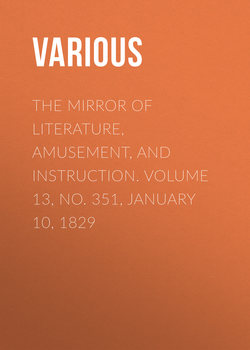The Mirror of Literature, Amusement, and Instruction. Volume 13, No. 351, January 10, 1829

Реклама. ООО «ЛитРес», ИНН: 7719571260.
Оглавление
Various. The Mirror of Literature, Amusement, and Instruction. Volume 13, No. 351, January 10, 1829
MACCLESFIELD BRIDGE, REGENT'S PARK
MACCLESFIELD BRIDGE
TRIBUTES TO THE DEAD, &c
SONG
CHARLES BRANDON, AFTERWARDS DUKE OF SUFFOLK
THE TOPOGRAPHER
CARMARTHEN
THE SKETCH BOOK
WATERLOO, THE DAY AFTER THE BATTLE
NOTES OF A READER
GERMAN SCHOOLS
EATING AND WRITING
SACRED POETRY
SUPERSTITION
"FELLOW" FEELING
CULTIVATION OF WASTE LANDS
CHINESE NOVELS
SPIRIT OF THE PUBLIC JOURNALS
TWENTY-EIGHT AND TWENTY-NINE
MORAL EFFECT OF ROME UPON THE TRAVELLER
SONG, BY T. CAMPBELL
SCHOOL AND COLLEGE
SPIRIT OF DISCOVERY
RETROSPECTIVE GLEANINGS
ENGLISH ROADS
THE GATHERER
MADEMOISELLE MARS
DRINKING
A "MELTING SUBJECT."
LIMBIRD'S EDITION OF THE
Отрывок из книги
This picturesque structure crosses the Canal towards the Northern verge of the Regent's Park; and nearly opposite to it is a road leading to Primrose Hill, as celebrated in the annals of Cockayne as was the Palatino among the ancient Romans.
The bridge was built from the designs of Mr. Morgan, and its construction is considered to be "appropriate and architectural." Its piers are formed by cast-iron columns, of the Grecian Doric order, from which spring the arches, covering the towing-path, the canal itself, and the southern bank. The abacus, or top of the columns, the mouldings or ornaments of the capitals, and the frieze, are in exceeding good taste, as are the ample shafts. The supporters of the roadway, likewise, correspond with the order; although, says Mr. Elmes, the architect, "fastidious critics may object to the dignity of the pure ancient Doric being violated by degrading it into supporters of modern arches." The centre arch is appropriated to the canal and the towing-path, and the two external arches to foot-passengers, and as communications to the road above them. Mr. Elmes1 sums up the merits of the bridge as follows:—"It has a beautiful and light appearance, and is an improvement in execution upon a design of Perronet's for an architectural bridge, that is, a bridge of orders. The columns are well proportioned, and suitably robust, carrying solidity, grace, and beauty in every part; from the massy grandeur of the abacus, to the graceful revolving of the beautiful echinus, and to the majestic simplicity of the slightly indented flutings." He then suggests certain improvements in the design, which would have made the bridge "unexceptionably the most novel and the most tasteful in the metropolis. Even as it is, it is scarcely surpassed for lightness, elegance, and originality by any in Europe. It is of the same family with the beautiful little bridge in Hyde Park, between the new entrance and the barracks."
.....
The king, charmed with this act of gallantry, so congenial to his own mind, inquired the name and family of the stranger; and not only repossessed him of his patrimonial estates, but took him under his immediate protection.
It was this same Charles Brandon who afterwards privately married Henry's sister, Margaret, queen-dowager of France; which marriage the king not only forgave, but created him Duke of Suffolk, and continued his favour towards him to the last hour of the duke's life.
.....